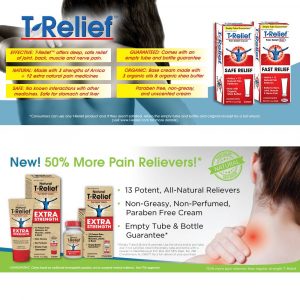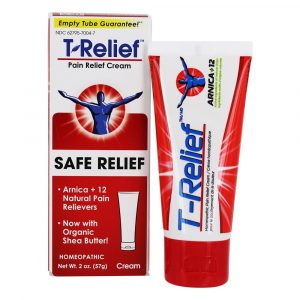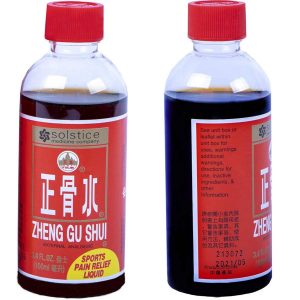Topical Pain Relief Formulas Are Popular & Can Help With Muscle & Joint Pain Relief
Many products that are applied for topical pain relief use herbs as active or inactive components providing an analgesic and/or counter-irritant to disrupt pain signals which travel to the brain. These components induce a cooling or warming sensation and can have an effect on the local blood circulation.
Common ingredients In Topical Pain Relief Formulas
- Menthol, when applied on skin will selectively stimulate nerve endings which are sensitive to cold, thus inducing the cooling sensation. It additionally produces a localized analgesic or pain relieving effect.
- Wintergreen is one of the naturally fragrant herbs for pain, often used as an oil providing a compound called Methyl Salicylate. It is a natural chemical relative of aspirin also and can reduce inflammation related pain as well as dilating blood vessels, improving circulation.
- Distilled from camphor wood, Camphor, often included in formulas and has a very fragrant, aromatic property and is quite penetrating when used for topical pain relief. It has a warming sensation, alleviates pain and decreases swelling and inflammation, improves circulation of blood as well as a common ingredient used topically for contusions, bruises, muscle strain, joint sprain and traumatic injuries.
- Extracted from red chili peppers, Capsaicin is the chemical substance which gives chili peppers its heating properties. When used for pain relief, it reduces a chemical found in nerve endings called Substance P, which transmits nerve as well as joint pain signals directly to the brain. Pain relief is not felt immediately upon application because it takes an accumulation of depleting Substance P during a time frame of a couple weeks until the full effects are felt.
- Lidocaine is used to numb tissue in specific areas and is considered a local anesthetic. It helps to reduce sharp, aching, and burning pain along with sensitivity discomfort to touch. It has recently become more popular as a prescription and over the counter topical pain reliever.
While these ingredients are commonly utilized in topical pain relief products and can be easily applied to the neck, however, it is the combination of ingredients in the formulation which produces a synergistic effect, promoting the healing and pain relieving properties with greater effect than a single ingredient preparation. Combinations of herbs and other ingredients may be formulated to enhance blood circulation and/or promote the healing of muscles, tendons, ligaments and joints. Remember that any topical preparation may be irritating to the skin in sensitive individuals. Any preparation should be tried on a small area first to determine any negative reactions and should never be applied to the skin prior to using a heating pad or ice pack, due to impaired sensation.
Having studied Chinese Martial Arts for many years, I frequently use these topical formulas for pain from injuries for both acute as well as chronic pain conditions that develop from serious or improperly healed injuries.
There are many ways to apply these topicals, from creams, roll-on’s, liniments, and patches. They all have their pros and cons.
Pain Patches
 A pain patch is an easy method for topical pain relief application as they are infused with herbs, usually in formulas. They are a great method for application of healing herbs to the affected area without the mess and clean up associated with lotions, gels, creams and liniments. The herbs mold to the injured area and penetrate the tissues. One application can provide pain relief for many hours or even days without the need to re-apply.
A pain patch is an easy method for topical pain relief application as they are infused with herbs, usually in formulas. They are a great method for application of healing herbs to the affected area without the mess and clean up associated with lotions, gels, creams and liniments. The herbs mold to the injured area and penetrate the tissues. One application can provide pain relief for many hours or even days without the need to re-apply.
They can also be used with an acute injury to bandage the area, applying pressure to reduce swelling like an ankle injury. Again, do not use under a heating pad or hot pack and, at first, test the area by applying a small piece of the pain patch and, after a short while, check for skin sensitivity. Additionally, you may want to remove hair from certain areas before application as they can be very be sticky and might be painful when removing. Furthermore, like most topical herbal products, they usually carry a medicinal or herbal odor. Conditions like sweating may interfere with consistent and uniform adherence.
Liniments
When studying Martial Arts, we used a complex herbal liniment that contained many different herbs. Made personally by the Sifu (teacher), we used it for just about any injury as well as a way to strengthen the bones for techniques such as iron palm and iron arm. It was truly remarkable how well it worked, however, this was an herbal formula passed down for generations, time tested and formulated according to results in the field. Over the years, the formula had to be modified according to availability and legality of some of the ingredients. It could not be used in cuts or bleeding situations.
It was common to heat the liquid formula for injuries that were more serious and painful and either bandage the area with it or soak the inured part for extended periods. The herbal liniment here is a very good formula containing both herbs for pain as well as healing. It can be used with cuts and bleeding and has antiseptic properties as well. This liniment is great for using with massage for muscle strains, joint sprains and to compliment healing of bruises. I find the liniment to be quite effective for topical pain relief when used judiciously and possesses a very pleasing fragrance, which adds a touch of aroma therapy. That being said, it can be messy and spilled if you are not careful
Creams
Creams can be very effective for topical pain relief. There are some formulas that do not contain irritants or ingredients that alter sensation, therefore, may be used with heating pads, brace, and ice packs. Massaging in the cream based formulas add another measure or therapeutic approach. Light if it is an acute injury, and deeply if it is a chronic condition. Often used in conjunction with massage therapy, some creams incorporate ingredients like glucosamine, chondroitin, hyaluronic acid and others that can be beneficial to the skin as well as joint pain.
Roll On’s
This is a great way to apply these formulas without the mess of having to handle the lotion. It is cost effective in that there is very little wasted. They are easy to use and can be taken anywhere. The problem, as with creams and liniments, is that you are limited to the areas of application to mobility. If you have shoulder pain, you might have difficulty in applying to areas that may involve moving that area. Likewise, reaching around to your upper or lower back may require the assistance of another person.

What Can Topical Pain Relief Formulas Help?
These formulas are commonly sought for problems with muscles and joint ailments. These conditions include joint inflammation seen with arthritis, tendons which connect muscles to bones that become inflamed in tendinitis, as well as the fluid filled sacs called bursa, which aid in ease of motion of tendons and become damaged or irritated when injured, and this state of inflammation is called bursitis. Bursitis is actually more common than realized. However, these are all conditions that can get confused in assessment.
Topicals are often used in conjunction with other therapeutic measures. It is just important to know when not to use ones that alter sensation in order to avoid further injury from overuse or in conjunction with things like heating pads in order to avoid burns or ice packs in order to avoid frost bite damage.
A 2015 report in Cochrane Database of Systematic Reviews concluded, “Topical NSAIDs provided good levels of pain relief in acute conditions such as sprains, strains and overuse injuries, probably similar to that provided by oral NSAIDs.”
A 2020 report in the American Family Physician indicates, “Topical NSAIDs [non-steroid anti-inflammatory drugs] are the most effective intervention for acute musculoskeletal pain other than low back pain.”
Benefits Of Topical Pain Relievers
 Instead of delivering an anti-inflammatory orally, that has systemic effects, topicals use a cutaneous or transcutaneous form of delivery via the skin. The ingredients are applied directly to the site of pain with the intention of reducing or altering sensory nerves and/or reducing inflammation of bursa, muscles, tendons, ligaments and nerves.
Instead of delivering an anti-inflammatory orally, that has systemic effects, topicals use a cutaneous or transcutaneous form of delivery via the skin. The ingredients are applied directly to the site of pain with the intention of reducing or altering sensory nerves and/or reducing inflammation of bursa, muscles, tendons, ligaments and nerves.
Using topical pain relief preparations can be a very easy, inexpensive, and effective way to combat pain and heal from injuries. They are usually a natural alternative to drugs. There is no shortage of preparations, however, we try to narrow it down to what we feel is effective, depending on your circumstances. For some of the more painful conditions, a counter-irritant can help with pain, although can interfere with ice applications.
In general, I do not prefer the patches as they can be irritating over long term and may cause skin breakdown that can be deleterious. This is similar to some popular methods of therapy like taping with self adhering tape for musculoskeletal conditions. I have seen too many complications with skin breakdown for a temporary assist that is repeated. So, for short term acute conditions.
A 2020 article in Postgraduate Medicine Interest in and use of topical analgesics has been increasing due to their utility potential for acute and chronic pain relief. Topically applied agents with analgesic properties can effectively target pain pathways while minimizing internal use potential systemic adverse effects. The authors conclude, “Clinicians should consider local anesthetics and other topical agents as part of their multimodal treatments of acute and chronic pain.”












